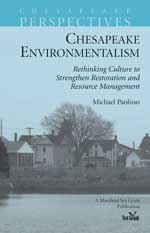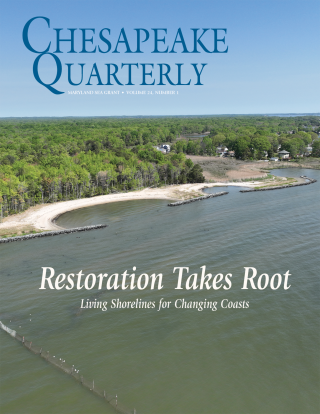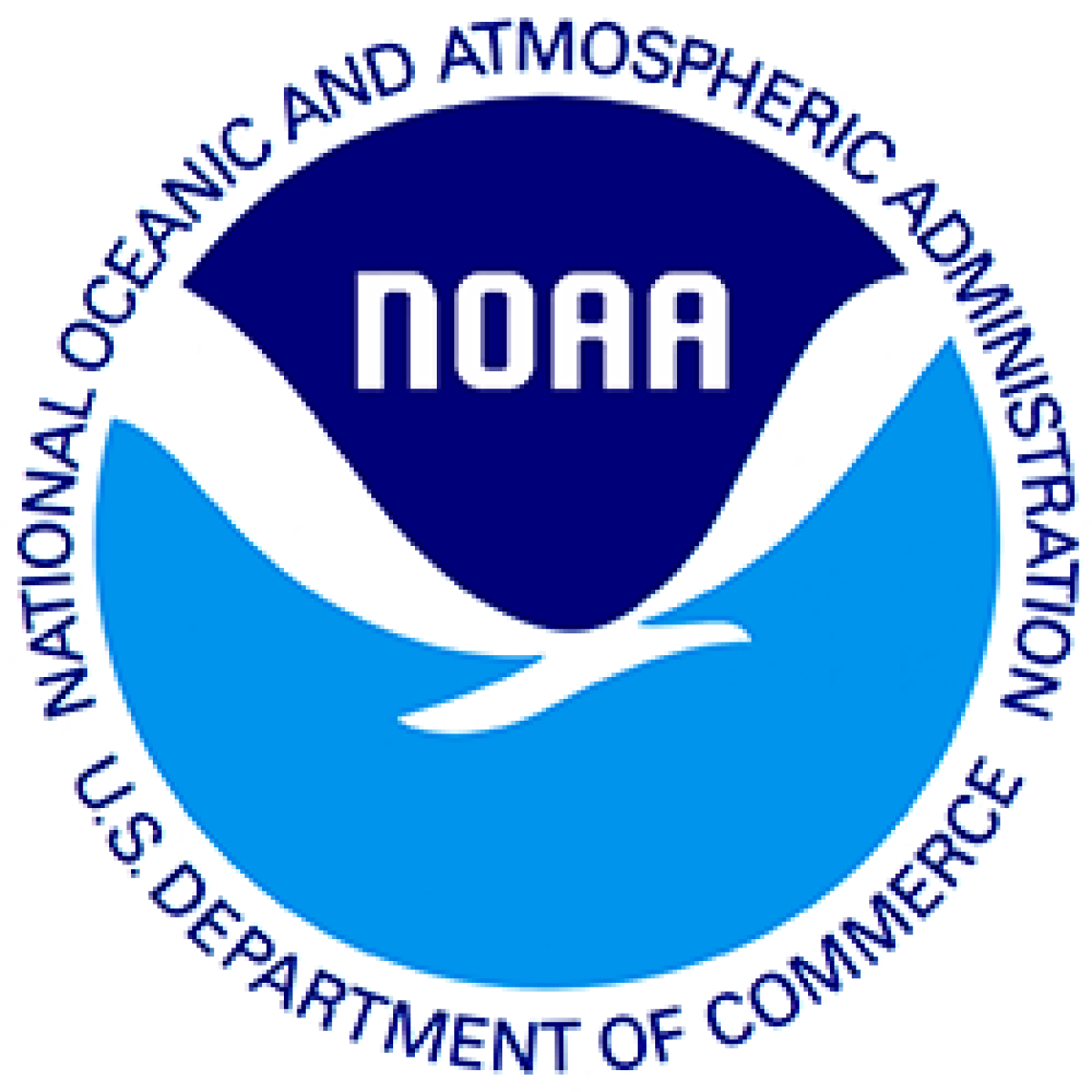Knauss legislative fellowships in Congress help build careers — and they're fun and educational. See our video and fact sheet for details.
Watershed Restoration
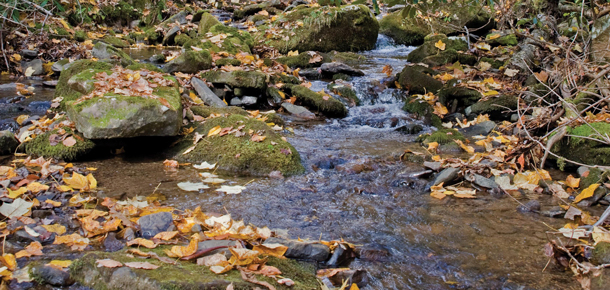
The Chesapeake Bay covers thousands of square miles, so it’s a tall order to restore the health of this ecosystem. Making progress requires a focused, local approach and many volunteers working stream by stream, community by community.
Maryland Sea Grant Extension offers a range of technical advice and support to help individuals and communities around the state improve water quality. We assist municipal governments, watershed groups, and others to fund, design, and install projects that will make a difference.
How You Can Help Protect the Watershed
- Plan a watershed restoration project. Browse our Maryland Watershed Restoration Assistance Directory to find organizations that provide funding or give technical assistance to support these efforts.
- Become a watershed steward. Maryland Sea Grant has helped to establish Watershed Stewards Academies around Maryland that train volunteers to take leadership roles in their communities to restore and preserve the Bay’s watershed. Participants learn to plan and lead projects to clean up streams and reduce stormwater flows that pollute the Bay.
- Learn about TMDLs. See our information and resources about these government-mandated limits, called Total Maximum Daily Loads. These are federal and state goals for reducing the amount of nutrients and sediments that are delivered to the local waterways and that in turn flow into the Bay. Communities may undertake new projects in order to be on track to meet these goals by 2025 as required.
Collecting Stormwater to Help Watersheds
Maryland Sea Grant’s team of watershed restoration specialists works actively to address a persistent threat to water quality -- stormwater runoff.
During big rains, water pools up and washes over hard surfaces like parking lots, roofs, and roads. This runoff picks up nitrogen, phosphorus, and other pollutants, carrying them to nearby streams and rivers and, eventually, the Chesapeake.
Our Extension specialists assist communities throughout the Bay’s watershed to better manage their storm water. Some projects that can help include:
- Rain gardens: These are deep gardens that soak up the storm water flowing off a roof or down a road. With the right design, rain gardens can also help to decontaminate storm water, retaining pollutants.
See more information from Maryland Sea Grant about rain gardens.
Read “A Garden of Opportunities for Cleansing Urban Storm Runoff,” an article in Chesapeake Quarterly, Maryland Sea Grant’s magazine.
- Rain barrels: Rain barrels catch water flowing off your roof or down the gutter during a big storm. That allows you to store storm water until it’s no longer raining -- once the ground is dry, you can add that water to your lawn or rain garden.
- Plant, plant, plant: Some of the most powerful tools for watershed stewards are native plants. Trees planted along city streets or in wilderness areas can help to trap the excess nutrients and sediments in rainwater. Native flowers and marsh vegetation planted around ponds can help to keep those water bodies clean, too.
How many homeowners have installed rain gardens? And what would it take for more to do so? A University of Maryland Extension report and survey examines awareness and adoption of four Best Management Practices for controlling stormwater: rain gardens, rain barrels, low fertilizer lawn care, and conservation landscaping.
To learn more about how stormwater can impact waterways, and how you can help, read Renewing an Urban Watershed, an issue of Chesapeake Quarterly, Maryland Sea Grant's magazine.
Additional Resources
- From My Backyard to Our Bay: A Dorchester County Homeowner's Guide: Actions to Improve the Water Quality of the Chesapeake Bay. This booklet was created through a partnership with Dorchester and Talbot County Master Gardeners, Dorchester Citizens for Planned Growth, the League of Women Voters, and the University of Maryland Sea Grant Extension Program. It's full of great tips for low cost and manageable practices to do on your own property. Access the electronic version here or pick up a hard copy at the Dorchester Extension office.
- Headwaters, the electronic newsletter of the Maryland Sea Grant Extension watershed restoration specialists.
- Evaluation of Climate Resilient Stormwater Management Practices for the Mid-Atlantic Region
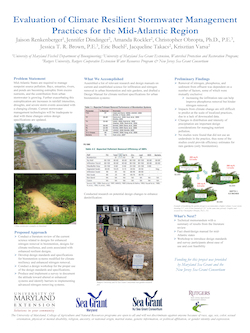 | This award-winning poster by the Extension watershed restoration specialists describes their study of stormwater management practices. |
Habitat Restoration
Our watershed restoration experts also work to help communities and watershed groups restore natural habitats across Maryland. Healthy ecosystems help to trap nutrients and sediments before they reach the Bay. Some of our efforts include:
- Marsh restoration – The Chesapeake’s wetlands are home to birds, fish, and dozens of Bay animals. But they’re also potent tools for keeping water clean. Marsh vegetation and microorganisms filter water streaming toward the estuary.
- Forest buffers – Like marshes, trees planted along a stream can also trap the excess nutrients and sediments in rainwater. To learn more about how trees affect water quality across the watershed, read Can Trees Save the Bay? an issue of Chesapeake Quarterly, Maryland Sea Grant’s magazine.
- Stream restoration – Healthy streams can be a boon for the Bay. Plants and microorganisms living in and around small waterways capture excess nutrients. But, because of development and other factors, many local streams around Maryland have lost much of their capacity to do just that. We support efforts to restore these beneficial functions to the state’s small waterways.
To learn more about restoring Maryland streams, read our news stories:
“Accurate Maps Needed to Protect Streams in the Headwaters of the Chesapeake”
“Restoring Streams May Reduce Nitrogen Pollution in the Chesapeake Bay”
Benefits of Watershed Restoration
Cleaner water provides benefits at the local level and Baywide:
- Drinking water: Various pollutants may, at times, build up in many of the freshwater streams and rivers that supply drinking water to towns across the state. Reducing the pollutants, such as heavy metals, and excess nutrients, which cause harmful blooms of algae, that enter small waterways can ensure the sustainability of your town’s water supply.
- Habitat: Clean waterways provide living space for diverse wildlife, including birds, frogs, fish, and countless plant species.
- Recreation: Vibrant streams, rivers, lakes, and ponds are excellent venues for fishing, hiking, biking, and many more outdoor activities.
